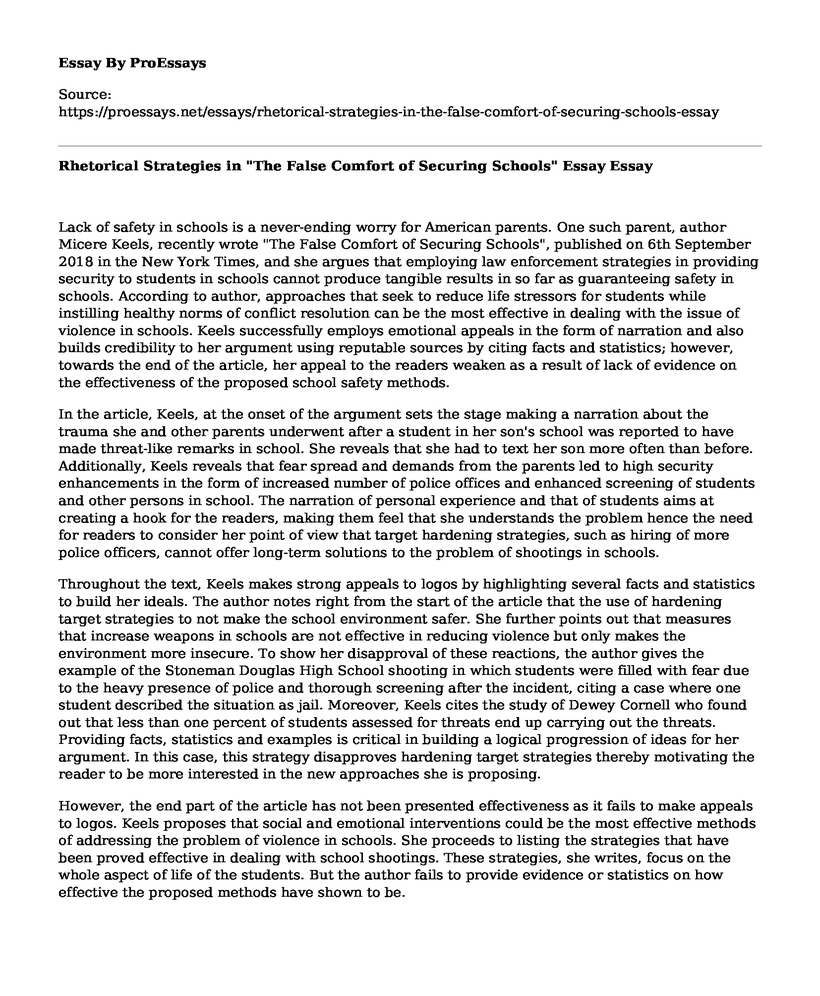Lack of safety in schools is a never-ending worry for American parents. One such parent, author Micere Keels, recently wrote "The False Comfort of Securing Schools", published on 6th September 2018 in the New York Times, and she argues that employing law enforcement strategies in providing security to students in schools cannot produce tangible results in so far as guaranteeing safety in schools. According to author, approaches that seek to reduce life stressors for students while instilling healthy norms of conflict resolution can be the most effective in dealing with the issue of violence in schools. Keels successfully employs emotional appeals in the form of narration and also builds credibility to her argument using reputable sources by citing facts and statistics; however, towards the end of the article, her appeal to the readers weaken as a result of lack of evidence on the effectiveness of the proposed school safety methods.
In the article, Keels, at the onset of the argument sets the stage making a narration about the trauma she and other parents underwent after a student in her son's school was reported to have made threat-like remarks in school. She reveals that she had to text her son more often than before. Additionally, Keels reveals that fear spread and demands from the parents led to high security enhancements in the form of increased number of police offices and enhanced screening of students and other persons in school. The narration of personal experience and that of students aims at creating a hook for the readers, making them feel that she understands the problem hence the need for readers to consider her point of view that target hardening strategies, such as hiring of more police officers, cannot offer long-term solutions to the problem of shootings in schools.
Throughout the text, Keels makes strong appeals to logos by highlighting several facts and statistics to build her ideals. The author notes right from the start of the article that the use of hardening target strategies to not make the school environment safer. She further points out that measures that increase weapons in schools are not effective in reducing violence but only makes the environment more insecure. To show her disapproval of these reactions, the author gives the example of the Stoneman Douglas High School shooting in which students were filled with fear due to the heavy presence of police and thorough screening after the incident, citing a case where one student described the situation as jail. Moreover, Keels cites the study of Dewey Cornell who found out that less than one percent of students assessed for threats end up carrying out the threats. Providing facts, statistics and examples is critical in building a logical progression of ideas for her argument. In this case, this strategy disapproves hardening target strategies thereby motivating the reader to be more interested in the new approaches she is proposing.
However, the end part of the article has not been presented effectiveness as it fails to make appeals to logos. Keels proposes that social and emotional interventions could be the most effective methods of addressing the problem of violence in schools. She proceeds to listing the strategies that have been proved effective in dealing with school shootings. These strategies, she writes, focus on the whole aspect of life of the students. But the author fails to provide evidence or statistics on how effective the proposed methods have shown to be.
Conclusion
Despite making an effective appeal from the start on the need to abandon hardening target strategies of fighting violence in schools, Micere loses track at the end of the article in convincing the audience about her argument. The readers can identify the weaknesses with current strategies of preventing violence in schools; however, lack of evidence and statistics the effectiveness of the proposed techniques dilutes her main argument about new strategies. This leaves the reader somewhat confused about the helpfulness of these methods in addressing the issue of violence on campus.
Works Cited
Keels, Mecere. "The False Comfort of Securing Schools." The New York Times, [New York], 2018.
Cite this page
Rhetorical Strategies in "The False Comfort of Securing Schools" Essay. (2022, Aug 10). Retrieved from https://proessays.net/essays/rhetorical-strategies-in-the-false-comfort-of-securing-schools-essay
If you are the original author of this essay and no longer wish to have it published on the ProEssays website, please click below to request its removal:
- Architectural Theories That Have Dominated Western Architecture Essay
- The Importance of Appearance and Appearance in "Phantom of the Opera" Paper Example
- Essay Sample on Developmentally Appropriate Practice in Education
- Personal Statement: Msc Remote Sensing and GIS
- Essay Example on Music Tech: Impact of Mass Media and Innovations
- Essay on Opioid Misuse and Addiction in America: The Devastating Consequences
- Essay Example on Smartphones: Benefits and Risks for Students







